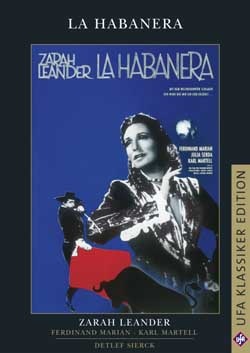
[center]La Habanera is a 1937 German melodramatic feature film directed by Detlev Sierck (later Douglas Sirk). Zarah Leander, recently signed by UFA, is the main star in the lead role of Astrée Sternhjelm and performs its title song, "La Habanera". Like many of her films of this era, it proved an enormous box office success.[/center]
[center]1937 - La Habanera.avi 699.4 MB
https://mega.co.nz/#!7BcRwQIA!KJaiujG4G ... vwabLno-dw[/center]
[center]Cast
Zarah Leander as Astrée Sternhjelm
Ferdinand Marian as Don Pedro de Avila
Karl Martell as Dr. Sven Nagel
Julia Serda as Ana Sternhjelm
Paul Bildt as Dr. Pardway
Edwin Jürgensen as Shumann
Boris Alekin as Dr. Luis Gomez
Carl Kuhlmann as prefect
Michael Schulz-Dornburg as Juan
Rosita Alcaraz as Spanish dancer
Lisa Helwig as old servant
Géza von Földessy as chauffeur
Werner Finck as Mr. Söderblom[/center]
[center]Plot summary[/center]
[justify]Astrée and her aunt from Sweden are vacationing in Puerto Rico. Astrée is enchanted by the local habanera music as well as by Don Pedro de Avila, a rich and powerful landowner and former bullfighter. Upon embarkation, she spontaneously decides to stay; she runs down the gangway, finds him waiting for her, and soon is married.
Ten years later - it is now 1937 - Astrée finds herself trapped in an unhappy marriage. Her paradise has turned to hell; her son, Juan, is her only reason to stay. Meanwhile in Stockholm, Dr. Sven Nagel, a former lover of Astrée, and his associate, Dr. Gomez, bid farewell. They are departing for Puerto Rico to investigate the mysterious and deadly Puerto Rico fever. On the island, their arrival is met with dismay by Don Pedro and his business associates as they fear the focus on the Puerto Rico fever will depress their business, so they plan to deny its existence. An earlier attempt by researchers from the Rockefeller Institute to find a cure had been a failure, and the resulting publicity had depressed the local economy and resulted in widespread famine.
Once in Puerto Rico the two investigators, receiving no local support, proceed to conduct their studies on their own in the hotel room. Meanwhile, Astrée has a fall-out with her husband about their son. He wants him to learn about bullfighting, while she has been teaching him about snow and Sweden. Thus Don Pedro decides to take the education of Juan out of her hands. Astrée in response books a passage to leave Puerto Rico with her son to return to Sweden. Meanwhile the Puerto Rico fever is starting to claim its first victims, and Drs. Nagel and Gomez search for a cure secretly.
Don Pedro learns about Astrée?s plans and suspects that Dr. Nagel is involved. He invites him for a soiree to have an opportunity to have his hotel room searched and gain evidence against him for his arrest and deportation. Thus at the soiree Dr. Nagel and Astrée meet and fall in love again. Astrée sings La Habanera presumably for her husband, but the song declares her love for the doctor. Don Pedro learns that the hotel room has provided the evidence to arrest Dr. Nagel. About to do so, he falls acutely ill. Dr. Nagel diagnoses Puerto Rico fever and calls for his newly developed antidote from his hotel room. However, it has been destroyed in the raid on his room; Don Pedro ?dug his own grave? and dies. Astrée is free to return with her lover and son to Sweden.[/justify]
[center][small]Comments[/small][/center]
[justify][small]This 1937 black-and-white movie was the penultimate film directed by Detlev Sierck in Germany before he emigrated to the United States. The film was produced within six months. In Hollywood, Sierck, now Sirk, continued to produce more melodramatic movies, yet on a grander scale. Zarah Leander had been hired by UFA, the German film company, in 1936, and was its new star. This movie shows her beauty and talents as Germany?s answer to Greta Garbo, and further presents her accomplishments as a singer. Bruno Balz, who wrote the text for the title song, would later be sent to a concentration camp - he was a homosexual. A funny scene with the comedian Werner Finck as Söderblom was cut by the censors, but restored after the war. This was the only film for the child actor Michael Schulz-Dornburg who played Juan; at the end of WWII, he was drafted and died at the age of 17 near Berlin in 1945.
The movie was not shot on Puerto Rico but the Canary Islands during the Spanish Civil War. It presents an interesting but fanciful image of Puerto Rico, mixing curiosity about the exotic, fantasy, and prejudice. The shepherds are wearing loincloths, and everybody speaks perfect German. The island appears to be run by selfish, authoritarian and corrupt local businessmen and landowners, and the movie is critical of the United States as the responsible party. In the film, habanera music (music that actually originated from Cuba) represents the soul of the island, its "erotic pull", it captivates and enchants Astrée for some time, but in the end she is happy to return home. The lesson for the contemporary German moviegoer was clear: it is better to stick to your roots. The film plays into the Nazi propaganda trying to repatriate Germans. With the demise of UFA, the rights of the film belong to the Friedrich Wilhelm Murnau Foundation.[/small][/justify]